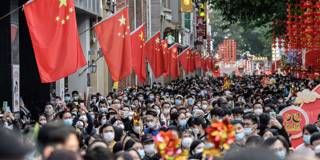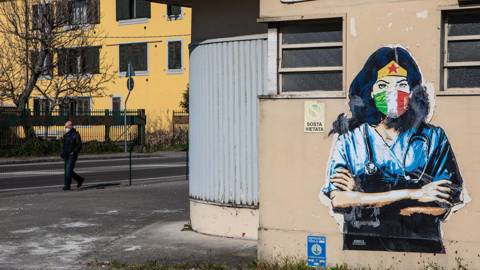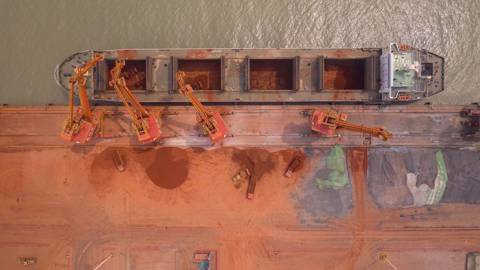Although the sudden end of China's zero-COVID policy led to a massive increase in infections as 2022 came to a close, it also positioned the economy for a long-awaited return to normalcy. With policymakers stressing consumption and providing stimulus and liquidity, China's growth outlook has improved dramatically.
KNOXVILLE – December 2022 brought a swift end to China’s zero-COVID policy – and an equally rapid rise in infections. But for all the disruptions that this shift caused, the Chinese economy is well positioned for a strong comeback this year. Three major trends to watch out for are a recovery in investment and consumption, a normalization of supply chains, and improvements in the hitherto troubled real-estate sector.
Partly because China’s long-delayed COVID-19 outbreak has been so rapid, it could prove relatively short-lived. Experts anticipate that the rise in infections will last only through the second quarter of 2023. While a May 2022 study in Nature predicted that China would have 112 million cases and 1.6 million deaths in the first six months following the end of zero-COVID, leaked health notes showed that 250 million people had already been infected before the end of December 2022. Several weeks later, a prominent government scientist estimated that 80% of the population had already been infected.
As long as China does not revert to its zero-COVID policy – and especially if it expands its medical capacity – it should be able to put economic growth back on track in the coming months. Workers will be able to return to factories and offices, truck drivers will be able to transport goods without delay, and businesspeople will be able to travel more freely. This is not wishful thinking; it was already starting to happen at the start of the year. Public-transit ridership and domestic travel had both risen despite the raging pandemic.
A significant uptick in economic activity should therefore be in the offing. While the zero-COVID policy’s intermittent city- and district-wide shutdowns reduced employment and private consumption markedly, its reversal is having an equal and opposite effect, especially since the government is championing lower unemployment and higher consumption as key indicators of economic health.
To be sure, the jobless rate across 31 cities had reached 6.7% in November 2022, and workers faced challenges in returning to work as the virus began to spread in December (when the purchasing managers’ index still reflected weakness in manufacturing). Nonetheless, some local governments encouraged even infected people to return to work if they had only mild symptoms, and by the end of the year, many Chinese, particularly in the largest cities, had adjusted to living with COVID.
Consumption will duly rise as people move freely and start purchasing more discretionary goods. Restaurants and shopping malls have reported increases in foot traffic and consumer spending, and the government’s annual Central Economic Work Conference emphasized consumer spending as a key priority. Following this guidance, local governments will likely expand the issuance of consumption vouchers (stimulus checks) as the year progresses.
Moreover, some of the major challenges facing supply chains are now being resolved. The late-2022 surge in infections hit factory and logistics workers so hard that some companies chose to start the Chinese New Year holiday early. Many domestic courier services were hobbled by a worker shortage. But with a stabilization of infections has come a normalization of logistics and manufacturing functions.
This does not mean that supply chains overall will remain stable. Rather, much will depend on the global outlook – in terms of both demand volatility and inflation – as well as geopolitical shocks stemming from Sino-American tensions and Russia’s war in Ukraine.
Finally, the outlook for China’s real-estate sector should start to improve. New rules announced in November 2022 have already alleviated some of the pressure on property developers, including by reducing the size of down payments, lowering mortgage rates, and encouraging new funding to developers through bonds and loans. These measures have strengthened market sentiment after two years of loan restrictions for developers. And some major cities, such as Chongqing, have also relaxed homebuying restrictions to shore up the local housing sector.
As a result, property analysts expect the commercial real-estate industry’s prospects to brighten by the middle of 2023 as demand rises in larger tier-one cities. Increased demand for retail space will help to combat looseness in the sector even as additional real-estate stock comes on the market as part of the post-COVID normalization.
Notwithstanding these likely positive developments, slowing global growth may still generate a powerful headwind for China. Numerous experts have predicted that the United States, along with one-third of all countries, will slip into recession in 2023. The International Monetary Fund forecasts a decline in global economic growth to 2.7% this year – the lowest rate in over two decades. These developments will inevitably hurt Chinese exports, which still account for 20% of the country’s GDP.
In anticipation of this shortfall, export-oriented Chinese businesses have heartily embraced the end of zero-COVID by courting overseas export orders and foreign investment. But whether this additional marketing activity will offset slowing global demand remains to be seen.
Renewed stimulus may help. China is expected to roll out fiscal support for its semiconductor industry and for new technology infrastructure, and the government will be heavily promoting electric-vehicle purchases and tourism. In late 2022, the Ministry of Finance announced a commitment to supporting innovation and rural development through tax cuts and other stimulus measures, and the People’s Bank of China has signaled that it will continue to provide liquidity and allow for credit growth.
All told, China’s 2023 outlook is vastly different from that of 2022, owing to the change in its COVID policy. The economy is poised for a rebound in many critical areas. Barring some new disruption, that will help propel it past three years of economic pain and paralysis.






KNOXVILLE – December 2022 brought a swift end to China’s zero-COVID policy – and an equally rapid rise in infections. But for all the disruptions that this shift caused, the Chinese economy is well positioned for a strong comeback this year. Three major trends to watch out for are a recovery in investment and consumption, a normalization of supply chains, and improvements in the hitherto troubled real-estate sector.
Partly because China’s long-delayed COVID-19 outbreak has been so rapid, it could prove relatively short-lived. Experts anticipate that the rise in infections will last only through the second quarter of 2023. While a May 2022 study in Nature predicted that China would have 112 million cases and 1.6 million deaths in the first six months following the end of zero-COVID, leaked health notes showed that 250 million people had already been infected before the end of December 2022. Several weeks later, a prominent government scientist estimated that 80% of the population had already been infected.
As long as China does not revert to its zero-COVID policy – and especially if it expands its medical capacity – it should be able to put economic growth back on track in the coming months. Workers will be able to return to factories and offices, truck drivers will be able to transport goods without delay, and businesspeople will be able to travel more freely. This is not wishful thinking; it was already starting to happen at the start of the year. Public-transit ridership and domestic travel had both risen despite the raging pandemic.
A significant uptick in economic activity should therefore be in the offing. While the zero-COVID policy’s intermittent city- and district-wide shutdowns reduced employment and private consumption markedly, its reversal is having an equal and opposite effect, especially since the government is championing lower unemployment and higher consumption as key indicators of economic health.
To be sure, the jobless rate across 31 cities had reached 6.7% in November 2022, and workers faced challenges in returning to work as the virus began to spread in December (when the purchasing managers’ index still reflected weakness in manufacturing). Nonetheless, some local governments encouraged even infected people to return to work if they had only mild symptoms, and by the end of the year, many Chinese, particularly in the largest cities, had adjusted to living with COVID.
Consumption will duly rise as people move freely and start purchasing more discretionary goods. Restaurants and shopping malls have reported increases in foot traffic and consumer spending, and the government’s annual Central Economic Work Conference emphasized consumer spending as a key priority. Following this guidance, local governments will likely expand the issuance of consumption vouchers (stimulus checks) as the year progresses.
SPRING SALE: Save 40% on all new Digital or Digital Plus subscriptions
Subscribe now to gain greater access to Project Syndicate – including every commentary and our entire On Point suite of subscriber-exclusive content – starting at just $49.99.
Subscribe Now
Moreover, some of the major challenges facing supply chains are now being resolved. The late-2022 surge in infections hit factory and logistics workers so hard that some companies chose to start the Chinese New Year holiday early. Many domestic courier services were hobbled by a worker shortage. But with a stabilization of infections has come a normalization of logistics and manufacturing functions.
This does not mean that supply chains overall will remain stable. Rather, much will depend on the global outlook – in terms of both demand volatility and inflation – as well as geopolitical shocks stemming from Sino-American tensions and Russia’s war in Ukraine.
Finally, the outlook for China’s real-estate sector should start to improve. New rules announced in November 2022 have already alleviated some of the pressure on property developers, including by reducing the size of down payments, lowering mortgage rates, and encouraging new funding to developers through bonds and loans. These measures have strengthened market sentiment after two years of loan restrictions for developers. And some major cities, such as Chongqing, have also relaxed homebuying restrictions to shore up the local housing sector.
As a result, property analysts expect the commercial real-estate industry’s prospects to brighten by the middle of 2023 as demand rises in larger tier-one cities. Increased demand for retail space will help to combat looseness in the sector even as additional real-estate stock comes on the market as part of the post-COVID normalization.
Notwithstanding these likely positive developments, slowing global growth may still generate a powerful headwind for China. Numerous experts have predicted that the United States, along with one-third of all countries, will slip into recession in 2023. The International Monetary Fund forecasts a decline in global economic growth to 2.7% this year – the lowest rate in over two decades. These developments will inevitably hurt Chinese exports, which still account for 20% of the country’s GDP.
In anticipation of this shortfall, export-oriented Chinese businesses have heartily embraced the end of zero-COVID by courting overseas export orders and foreign investment. But whether this additional marketing activity will offset slowing global demand remains to be seen.
Renewed stimulus may help. China is expected to roll out fiscal support for its semiconductor industry and for new technology infrastructure, and the government will be heavily promoting electric-vehicle purchases and tourism. In late 2022, the Ministry of Finance announced a commitment to supporting innovation and rural development through tax cuts and other stimulus measures, and the People’s Bank of China has signaled that it will continue to provide liquidity and allow for credit growth.
All told, China’s 2023 outlook is vastly different from that of 2022, owing to the change in its COVID policy. The economy is poised for a rebound in many critical areas. Barring some new disruption, that will help propel it past three years of economic pain and paralysis.